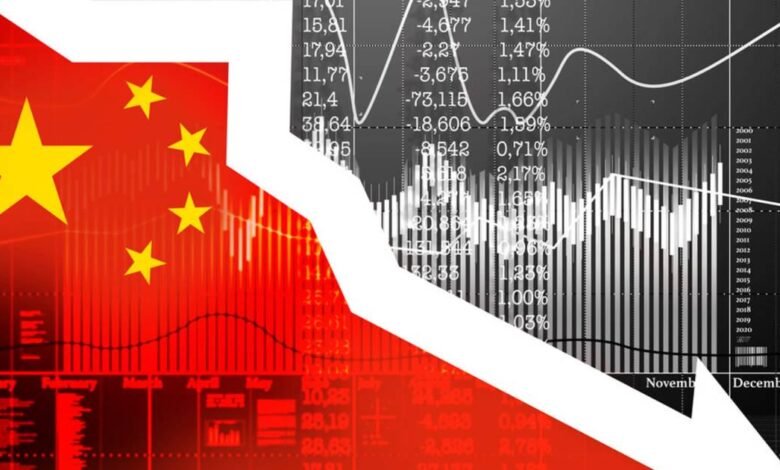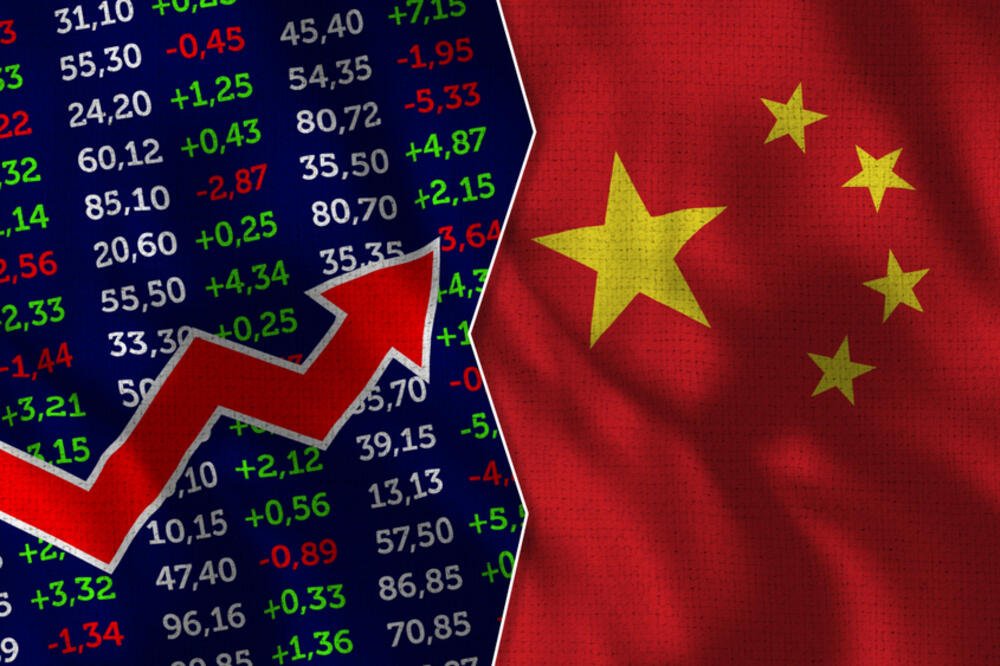Is the Vibrancy of the Chinese Market Slowing?

Is the Vibrancy of the Chinese Market Slowing?
Navigating the intricate landscape of global economics, many investors and analysts have averred that the vibrancy of the Chinese market is slowing. This perception of a Chinese market slowdown prompts an essential question: what precisely is the state of China’s economic growth today? To understand the vibrancy of China’s economy, one must delve into various factors such as domestic policy, industrial production, and consumer spending trends. Moreover, economic tensions like trade wars have undoubtedly played a significant role, altering the dynamics within the market. As we embark on this Chinese market slowdown analysis, we aim to dissect the factors affecting China’s market vibrancy and evaluate the impact of the global economy on the Chinese market. From the impact of Chinese economic slowdown on global commerce to an assessment of trends in Chinese market performance, this analysis not only reflects on historical data but also offers future projections for China’s economic vibrancy. Join us as we explore these essential dimensions, shedding light on the evolving economic powerhouse of the East.
Is the Vibrancy of the Chinese Market Slowing? Understanding the Current State of China’s Economy
Is the Vibrancy of the Chinese Market Slowing? As one of the most dynamic economies over the past few decades, China’s economic growth has intrigued investors, policymakers, and analysts globally. However, recent trends suggest the need for a deeper analysis into the factors behind the vibrancy of China’s economy and whether it’s truly experiencing a Chinese market slowdown.
Key Indicators of Economic Performance:
- GDP Growth Rate:
- Current: 4.5%
- Previous Year: 6.1%
- Unemployment Rate:
- Current: 5.3%
- Target: Below 5%
- Inflation Rate:
- Current: 2.4%
- Desired Range: 2-3%
From the table above, the Chinese market slowdown analysis highlights a moderated GDP growth rate and a mild increase in unemployment, which indicates a cautious approach towards future growth predictions.

Is the Vibrancy of the Chinese Market Slowing? Factors Affecting China’s Market Vibrancy:
- Domestic Consumption: A notable dip in consumer confidence may affect spending patterns, leading to sluggish retail numbers.
- Industrial Output: Fluctuations in manufacturing and exports are presenting challenges for sustainable industrial expansion.
- Policy Shifts: Government focus on reducing debt levels and financial risk may inadvertently hamper aggressive growth strategies.
Impact of Global Economy on Chinese Market: There is an interplay between trends in Chinese market performance and global economic dynamics. In recent times, the synchronization with global economic cycles suggests that external demand and trade relationships significantly impact China’s economic pulse.
A meticulous examination of these elements can provide a comprehensive view of the intricate landscape of China’s economic environment, narrating a tale not just of a potential slowdown but of a transitional phase with opportunities for recalibration and resilience building.
Factors Contributing to the Perceived Slowdown
Understanding what contributes to a perceived Chinese market slowdown is crucial for business analysts and investors alike. Though the once fast-paced growth of China’s economy was unparalleled, several factors now seem to be affecting the vibrancy of China’s economy. Here, we will explore a few pivotal elements influencing this shift.
- Industrial Reforms: China has been undergoing comprehensive industrial reforms aimed at transitioning from manufacturing to a more service-oriented economy. While this move is crucial for sustainable growth, it has initially contributed to a dip in productivity as industries adapt.
- Regulatory Changes: Stringent regulations, primarily in the technology and real estate sectors, have capped the aggressive expansion strategies companies followed for years, affecting overall growth rates.
- Export Challenges: With rising trade tensions, especially with Western economies, China’s export-driven growth faced considerable headwinds.
- Consumer Confidence: Domestic consumption, a critical driver of economic growth, shows a mixed picture. Challenges such as rising unemployment rates have affected consumer spending.
For a more structured understanding, consider the table below highlighting these factors:
| Factor | Description |
|---|---|
| Industrial Reforms | Shift to services impacting short-term growth. |
| Regulatory Measures | Increased regulation in tech and real estate sectors. |
| Export Challenges | Trade tensions leading to decreased international demand. |
| Consumer Confidence | Fluctuations in spending due to unemployment and other social factors. |
Furthermore, the impact of the global economy on the Chinese market can’t be ignored. Global economic downturns and rising geopolitical tensions also play a significant role. Collectively, these factors affecting China’s market vibrancy provide an insightful Chinese market slowdown analysis, enabling stakeholders to better comprehend the current dynamics and strategize accordingly.
Is the Vibrancy of the Chinese Market Slowing? Impact of Trade Wars on the Chinese Market
Trade wars have become a significant concern when assessing the Chinese market slowdown analysis. Recent years have seen escalating trade tensions, particularly between China and the United States, which have directly influenced the vibrancy of China’s economy. Understanding the impact of trade wars on the Chinese market requires examining several key aspects.
Tariffs and Economic Performance
One prominent feature of trade wars is the imposition of tariffs, which increase the cost of goods. In the case of China, these tariffs have affected a broad spectrum of industries, from electronics to agriculture. The increased costs often lead to reduced exports, impacting China’s GDP growth.
- Tariff effects:
- Increased product prices
- Decreased export volumes
- Dampened industrial investments
Supply Chain Disruptions
Trade tensions have also resulted in notable supply chain disruptions. Businesses reliant on cross-border supply chains have faced uncertainties regarding consistent supply and pricing. This unpredictability has caused many firms to reevaluate and sometimes relocate supply chains outside China, thereby affecting domestic industrial production and output.
- Supply Chain outcomes:
- Supplier relocations
- Investment in alternative markets
- Increased operational costs
Is the Vibrancy of the Chinese Market Slowing? Comparison of Economic Indicators
To better understand the impact of global economy on the Chinese market, a comparison of economic indicators before and during the trade wars can be revealing:
| Indicator | Pre-Trade War Period | During Trade War |
|---|---|---|
| Export Growth Rate | 7.9% | 1.5% |
| GDP Growth Rate | 6.9% | 6.3% |
| Manufacturing Output | Increased | Stagnated |
These impacts indicate a clear deceleration in economic vibrancy attributable to trade conflicts. As trade negotiations continue, the long-term effects remain uncertain, but the immediate consequences already suggest shifts in China’s economic growth patterns. Analyzing how these trade tensions unfold will be crucial in predicting whether the Chinese market slowdown is a temporary phase or indicative of a more persistent trend.
The Role of Domestic Policy in Economic Growth
Understanding the vibrancy of China’s economy necessitates a thorough examination of its domestic policies, which play a crucial role in shaping China’s economic growth. In recent years, the government has implemented a variety of strategic policies aimed at sustaining economic stability and fostering development. However, these policies have also faced criticism regarding their effectiveness and impact.
Key domestic policies impacting the Chinese market slowdown analysis include:
- Monetary Policy Adjustments: The People’s Bank of China frequently adjusts interest rates and reserve requirements to manage liquidity. This ensures that credit remains available to businesses while controlling inflation.
- Fiscal Stimulus Measures: The Chinese government has introduced fiscal stimulus packages targeting infrastructure development and technological innovation. These measures boost domestic demand and help maintain growth during global economic uncertainties.
- Regulatory Reforms: Initiatives to streamline government regulations, tackle corruption, and create a more transparent business environment aim to attract foreign investment and promote domestic entrepreneurship.
- Innovation and Technology Policies: Investment in technology and research and development has been prioritized to transition the economy from being manufacturing-led to innovation-driven.
Here’s a table summarizing factors affecting China’s market vibrancy:
| Policy Aspect | Potential Impact |
|---|---|
| Monetary Policy | Controls inflation, influences borrowing |
| Fiscal Stimulus | Boosts infrastructure, supports technology |
| Regulatory Reforms | Enhances governance, attracts investment |
| Innovation and Technology | Drives future growth, introduces new sectors |
While these domestic policies hold promise for long-term gains, they also present challenges. Regulatory complexities and the execution of reforms can occasionally suppress immediate economic momentum. Thus, evaluating trends in Chinese market performance against these policies is essential to forecasting the impact of the Chinese economic slowdown and gauging future recovery prospects. By examining how internal strategies shape the economy, we can better understand the impact of the global economy on the Chinese market and the pathways to revitalizing its vibrancy.
Is the Vibrancy of the Chinese Market Slowing? Assessing China’s Industrial Production and Output
When it comes to China’s economic growth, industrial production and output play pivotal roles. As the world’s manufacturing powerhouse, China significantly shapes its economic landscape through this sector. However, the question arises: Is the Vibrancy of the Chinese Market Slowing? To answer this, a deep dive into the trends in Chinese market performance is necessary.
Several factors influence China’s industrial production and output, which in turn affect the overall vibrancy of China’s economy. Key areas include:
- Technological Advancements: Adoption of automation and AI technologies is transforming manufacturing processes, enhancing productivity, and reducing costs.
- Labor Costs: Rising wages in China push industries to seek more efficient ways or relocate manufacturing bases, impacting industrial output levels.
- Environmental Policies: Stricter environmental regulations mean industries must invest in cleaner technologies, which can initially slow production but lead to sustainable growth long term.
To understand better, here’s a comparative table of some key indicators affecting China’s industrial production:
| Indicator | Current Status | Effect on Production |
|---|---|---|
| Technological Integration | Increasing | Boosts efficiency and output. |
| Labor Cost | Rising | Could decrease competitive edge. |
| Environmental Standards | More stringent | Initially costly, fosters innovation. |
Additionally, the impact of the global economy on the Chinese market cannot be understated. Global demand fluctuations, trade relations, and international policies continuously affect industrial output.
To conclude, while certain aspects of China’s industrial production may face challenges, they also open avenues for innovation and sustainability. A nuanced Chinese market slowdown analysis reveals that although there are hurdles, opportunities for growth and transformation abound. Thus, understanding these factors helps in predicting future trends in Chinese market performance and economic vibrancy.
Is the Vibrancy of the Chinese Market Slowing? Evaluating Consumer Spending Trends in China
Understanding consumer spending trends is crucial when discussing Is the Vibrancy of the Chinese Market Slowing? Over the years, consumer behavior and spending patterns have played a pivotal role in shaping China’s economic growth. Trends in Chinese Market Performance often reflect shifting purchasing habits, revealing insights into factors affecting China’s market vibrancy.
Key Trends in Consumer Spending
- Rising Middle Class: A burgeoning middle class has led to increased disposable income, directly impacting consumer spending. This group is gradually shifting their focus from purchasing essential goods to acquiring luxury items and services.
- E-commerce Boom: The exponential growth of e-commerce platforms like Alibaba and JD.com has changed how Chinese consumers shop, favoring convenience and a broader array of choices. Online shopping festivals, such as Singles’ Day, further stimulate consumer expenditure.
- Health and Wellness: An increasing awareness regarding health and wellness among Chinese consumers has led to a surge in demand for organic foods, fitness products, and healthcare services. This trend signifies a move toward more health-conscious spending habits.
Impact of Shifting Trends
These evolving trends suggest a positive outlook for certain sectors, yet they also highlight potential vulnerabilities. As the market adapts to these changes, businesses must remain agile, aligning product offerings with consumer interests. However, ongoing concerns about a Chinese market slowdown analysis persist, as external factors such as the impact of global economy on Chinese market influence domestic consumer confidence.
Comparative Consumer Spending
To evaluate the Impact of Chinese Economic Slowdown, it’s essential to compare past and current spending habits. Historically, China has seen double-digit growth in consumer expenditure. However, recent years show a moderate pace due to various economic challenges. This shift underscores the importance of monitoring consumer spending closely, as it is a significant indicator of the Vibrancy of China’s economy.
In conclusion, understanding consumer spending trends offers valuable insights into the broader economic landscape. As analysts and businesses navigate through these dynamics, attention to consumer behavior remains crucial for predicting and adapting to future changes in the Chinese market.
Is the Vibrancy of the Chinese Market Slowing? The Influence of Global Economic Conditions
The impact of the global economy on the Chinese market is a crucial factor when analyzing whether the vibrancy of China’s economy is indeed slowing. Several global economic trends play a significant role in this dynamic, affecting both growth prospects and market performance.
To understand this better, consider the following key global factors that influence China’s market:
External Economic Influences:
- Trade Partnerships: China’s trade relationships with major economies, such as the United States and the European Union, are pivotal. Any disruption in these ties, due to trade wars or tariff hikes, directly contributes to the Chinese market slowdown analysis.
- Currency Fluctuations: Changes in global exchange rates can alter the competitive landscape for Chinese exports, impacting revenue and market share.
- Interest Rates: Global interest rates, mainly those set by the U.S. Federal Reserve, can influence cross-border capital flows, affecting investment in China.
Table: Key External Influences on China’s Economic Growth
| Global Factor | Impact on China |
|---|---|
| Trade Partnerships | Alters export-import balance |
| Currency Fluctuations | Affects export competitiveness |
| Interest Rates | Influences foreign investment flows |
Furthermore, global phenomena such as pandemics, geopolitical tensions, and supply chain disruptions also dramatically shape trends in Chinese market performance. When these factors align negatively, they exacerbate existing domestic challenges, ultimately leading to a perceived Chinese market slowdown.
In conclusion, while the factors affecting China’s market vibrancy are diverse and interconnected, the global economy’s role is undeniably significant. Understanding these influences provides a comprehensive picture of China’s economic growth dynamics and how they may evolve.
Is the Vibrancy of the Chinese Market Slowing? Comparative Analysis: Past and Present Economic Growth
To address the question “Is the Vibrancy of the Chinese Market Slowing?”, it’s essential to perform a Comparative Analysis of China’s economic growth in the past versus its present status. Historically, China’s economy has been characterized by rapid expansion, driven predominantly by large-scale industrialization and urban development. However, in contemporary times, there appears to be a Chinese market slowdown in growth rates, prompting further investigation into the underlying reasons.
Past Economic Growth
- 1978-2010: China’s economic reforms led to an unprecedented period of growth, with annual GDP increases often exceeding 10%.
- Industrial Boom: Expansion in manufacturing and export sectors fueled this rapid escalation.
- Global Integration: China’s accession to the World Trade Organization in 2001 opened international markets, enhancing its growth prospects.
Present Economic Conditions
- 2010-Present: Growth rates have stabilized at approximately 6% to 6.5% in recent years.
- Shift to Services: The economy is transitioning from manufacturing to service-oriented industries.
- Innovation Focus: Increased emphasis on technology and sustainable development.
The factors affecting China’s market vibrancy today differ significantly from those in the past. Understanding these contrasts is pivotal in analyzing the Chinese market slowdown analysis and determining whether this depicts a negative trend or a natural evolution of a maturing economy.
| Key Periods | Main Drivers | Growth Rate |
|---|---|---|
| 1978-2010 | Industrialization, globalization | > 10% annually |
| 2010-Present | Services, innovation | ~6% to 6.5% annually |
Additionally, it’s important to consider the impact of global economy on Chinese market trends, such as the aftermath of global financial crises and trade dynamics. Overall, while slower than the past, today’s growth is still robust by global standards and suggests an adaptation rather than a decline.
Is the Vibrancy of the Chinese Market Slowing? Future Projections for China’s Economic Vibrancy
As global economists and analysts turn their eyes toward Asia, the vibrancy of China’s economy remains a pivotal subject of debate. Predictions for the future reveal a complex but promising path for the world’s second-largest economy.
Is the Vibrancy of the Chinese Market Slowing? Growth Potential in Innovation and Technology
- Technological Advancements: China is increasingly cementing its position as a leader in technological innovation. The country’s significant investments in AI, 5G technology, and green energy are expected to bolster its economic growth in the upcoming years.
- Start-Up Ecosystem: The booming tech sector and a supportive environment for start-ups offer immense opportunities for entrepreneurial growth, providing new avenues for economic resilience.
Anticipated Economic Shifts
Despite concerns about a Chinese market slowdown, future projections suggest that internal adjustments could stimulate long-term growth. Analysts highlight a shift from heavy industries to a more service-oriented economy as a key factor.
- Domestic Market Expansion: Enhanced urbanization and a burgeoning middle-class market are driving demand for services like healthcare, education, and financial products.
- Rural Development Initiatives: Strategic policies aimed at improving rural infrastructure and connectivity are likely to yield significant returns in broader economic engagement.
Potential Challenges and Global Interactions
- Impact of Global Economy on Chinese Market: Global uncertainties like fluctuating trade policies and geopolitical tensions remain significant challenges. However, continued efforts to diversify trade partnerships could mitigate these risks.
- International Collaborations: China’s Belt and Road Initiative and various international trade agreements are expected to enhance global market integration, offering substantial growth opportunities.
Is the Vibrancy of the Chinese Market Slowing? Forecast: A Dual Emphasis on Stability and Growth
While there is no denying that trends in Chinese market performance illustrate periods of deceleration, the future presents a dual emphasis on stability and dynamic growth. Governing bodies and economic reformists continue to focus on maintaining a balance between managed economic deceleration and innovation-driven expansion. Such balanced strategies aim to sustain China’s economic growth even amidst evolving global and domestic challenges. This approach ensures that factors affecting China’s market vibrancy are addressed proactively, paving the way for an adaptable and forward-thinking economic model.



